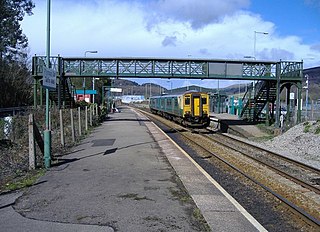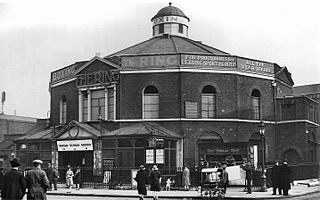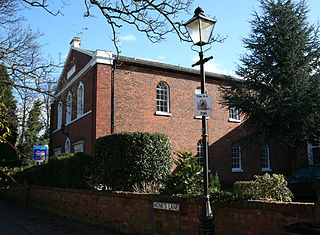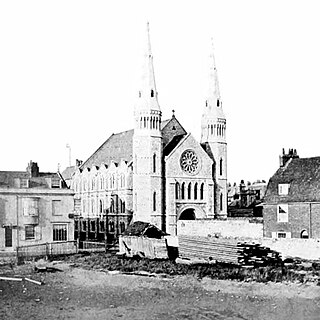
Taff's Well is a semi-rural village, community and electoral ward located at the south easterly tip of Rhondda Cynon Taf, 6 miles (9.7 km) to the north of Cardiff, the capital city of Wales. Known locally as the 'Gates to the Valleys', it is separated from Gwaelod-y-Garth by the River Taff. Taff's Well is distinguished because it contains the only thermal spring in Wales. The tepid water is thought to rise along a fault-line from the Carboniferous Limestone, in somewhat similar manner to the warm springs at Bristol and Bath. Various religious groups regard it as a spiritual site.

Howells was a large department store located on St Mary Street in Cardiff, Wales, established by James Howell in 1865. It was acquired by the House of Fraser group in 1972 and re-branded as House of Fraser in 2010.

Colchester in Essex, England, has a number of notable churches.

Cardiff Central bus station was the main bus transport interchange in the Cardiff city centre until it closed on 1 August 2015. With 34 stands, it was the largest bus station in Wales. It was located adjacent to Cardiff Central railway station forming a major interchange. Construction of a new bus and transport interchange on the site of the former NCP multi-storey car park in Wood Street, adjacent to the old bus station, is underway with an expected date of completion sometime in spring 2024.

The Surrey Chapel (1783–1881) was an independent Methodist and Congregational church established in Blackfriars Road, Southwark, London on 8 June 1783 by the Rev. Rowland Hill. His work was continued in 1833 by the Congregational pastor Rev. James Sherman, and in 1854 by Rev. Newman Hall. The chapel's design attracted great interest, being circular in plan with a domed roof. When built it was set in open fields, but within a few years it became a new industrial area with a vast population characterised by great poverty amidst pockets of wealth. Recently the site itself has been redeveloped as an office block, and Southwark Underground Station has been built opposite.

Architecture in Cardiff, the capital city of Wales, dates from Norman times to the present day. Its urban fabric is largely Victorian and later, reflecting Cardiff's rise to prosperity as a major coal port in the 19th century. No single building style is associated with Cardiff, but the city centre retains several 19th and early 20th century shopping arcades.

Temperance Town, Cardiff, was the unofficial name for a working-class inner-city suburb established in the late 1850s and demolished in the 1930s to make way for Cardiff Bus Station.

The Congregational Chapel, also known as the Independent Chapel, is a former Congregational or Independent church in Nantwich, Cheshire, England. It is located on Monks Lane, now a pedestrian walkway, opposite the Dysart Buildings and immediately north east of St Mary's Church. Built in 1841–42, it is listed at grade II. The chapel closed in the late 20th century, and the building has been converted to residential use.
Central Square is a large public space in Cardiff, Wales, adjacent to Cardiff Central railway station and included Cardiff Central bus station between 1954 and 2015. It was redeveloped and extended in the late 2010s and early 2020s.

Underbank Chapel is a Unitarian place of worship in Stannington, a suburb of Sheffield, South Yorkshire. It is a member of the General Assembly of Unitarian and Free Christian Churches, the umbrella organisation for British Unitarians.

West Park United Reformed Church is located in the West Park area of Harrogate, England, and is a Grade II listed building. It was designed in Nonconformist Gothic style as West Park Congregational Church by Lockwood & Mawson and completed in 1862 for around £5,000. Along with Belvedere Mansion across the road, it was intended as part of the prestigious entrance to the Victoria Park development. For the Congregationalists it was meant to house an increasing congregation of visitors brought to the spa town by the recently-built railways. It became a United Reformed church in 1972.

The building formerly known as Godalming Congregational Church was the Congregational chapel serving the ancient town of Godalming, in the English county of Surrey, between 1868 and 1977. It superseded an earlier chapel, which became Godalming's Salvation Army hall, and served a congregation which could trace its origins to the early 18th century. The "imposing suite of buildings", on a major corner site next to the Town Bridge over the River Wey, included a schoolroom and a manse, and the chapel had a landmark spire until just before its closure in 1977. At that time the congregation transferred to the nearby Methodist chapel, which became a joint Methodist and United Reformed church with the name Godalming United Church. The former chapel then became an auction gallery before being converted into a restaurant; then in 2018 the premises were let to the Cotswold Company to be converted into a furniture and home accessories showroom. In 1991 the former chapel was listed at Grade II for its architectural and historical importance.

Pilgrim Uniting Church is a Uniting church located on Flinders Street, Adelaide in South Australia.

Jackson Hall is a Grade II listed building on Westgate Street, in central Cardiff. It was designed by John Prichard and George Robinson and built in 1878. It stands adjacent to the Cardiff and Country Club. Behind Jackson Hall is the Millennium Stadium.

Allin Congregational Church is an historic United Church of Christ church in Dedham, Massachusetts. It was built in 1818 by conservative breakaway members of Dedham's First Church and Parish in the Greek Revival style.

Clayton Wesley Uniting Church, formerly Clayton Congregational Church, is a Uniting church, located at 280 Portrush Road, Beulah Park, Adelaide, South Australia, Australia. The current building with its tall spire was built was built in 1883, although an earlier building, behind the present church and now known as the Lecture Hall, was built in 1856. The church is located in a commanding position at the eastern end of The Parade, Norwood.
Brisbane Street is a street in Hobart, Tasmania. The street was named for Sir Thomas Makdougall Brisbane, the sixth Governor of New South Wales.

The Weybridge United Reformed Church situate at Queen's Road, Weybridge, near to its junction with York Road, is a Victorian Grade II Listed church building that is now no longer used as a place of worship.

Gloucester Street Congregational Church was a Congregational church in Weymouth, Dorset, England. It was built between 1862 and 1864 to replace a chapel of 1804 at St. Nicholas Street. It closed as a place of worship in 1971 and was demolished in 1980. The site is now occupied by the retirement housing complex, George Thorne House.


















